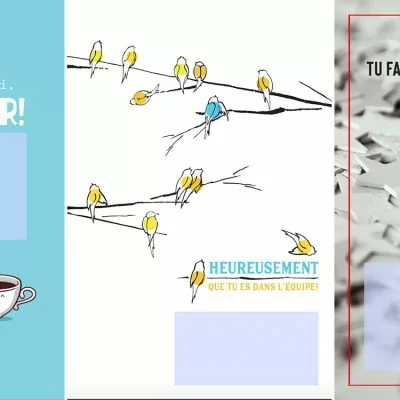How to Give the Best Employee Recognition Speech
February 17, 2020In Employee Engagement

As a manager, you probably find yourself making recognition speeches to your team frequently in an informal way. Whether it be in weekly meetings, to share recent results or announcing a new hire, communicating informally in front of your team will become second nature.
A formal speech on the other hand, is less frequent, but equally important. A formal employee recognition speech is in order when celebrating a milestone such as your employee’s years of service, the success of a transformational project, or the launch of a new initiative.
In both cases, it’s essential to adapt what you say, and how you say it, to your audience and to the importance of the message you are delivering. Ultimately, a great speech will have a big impact on the motivation and engagement of your employees!
Whether or not public speaking isn’t your strong suit, following these simple tips will ensure your employees feel appreciated and your message of recognition is communicated strongly!
Step 1: Define your Content
Be specific
For recognition to be effective, it must be specific. Make sure to mention why you are recognizing the person or the team. Listing someone’s many qualities is nice, but to really have an impact on motivation, you must mention the behaviors you wish to reinforce. Specificity can take many forms:
- A habit: “Nya takes the time to say hello to everyone on her team every day”
- A specific action: “Rachid went above and beyond and personally visited the venue on the weekend to make sure everything was setup properly for SuperClient’s event the next day”
- An anecdote: “A few weeks ago, I noticed Emma’s clothes were completely covered in dust. As I was about to send her home to change, I noticed the shipping area – it was immaculate! Thanks, Emma, for your initiative to clean this area to make it more comfortable for everyone.”
Explain the impact
It’s essential to express the effect that the behavior had on the team, on yourself, or on the clients. Pointing out how the good deed impacted other people will multiply the effect of recognition. In the same line of thought, an example could be: “Nya takes the time to say hello to everyone on her team every day. Thanks to this small gesture, the mood on the team has been more positive, and everyone looks forward to Nya’s arrival in the morning.”
Say Thank You
Whatever you say, you must say “Thank You!” It’s so simple that it’s often forgotten in recognition speeches, yet these two little words have a big impact. Ideally, you want to end your speech with it, and you can use it multiple times throughout as well!
Step 2: Body Language Checklist
- Make eye contact: When speaking about someone, make eye contact with them and other people in the room. Try to move your gaze across the audience calmly from left to right. Additionally, make sure to look at the person being recognized when you say thank you!
- Avoid jittery movements: Try to keep your hands calm and avoid tapping your feet. If you are standing, think about moving slowly. If you are sitting, keep your legs and feet calm and use your hands to express yourself.
- Use your hands to match your words: Ideally, you want your hands and arms to support the message you are delivering. For example, if you say “your immense generosity” – open your arms to visually represent the adjective. It’s important to practice your speech and gestures ahead of time so that the combination of the two becomes natural – like a dance choreography!
- Walk around: When you are on stage, try not to stay behind a pedestal. The proximity between you and your employees will make the message seem more personal and movement will make your recognition speech more dynamic and interesting.
- Take pauses: When making an important point, stand in place so that the emphasis is put on your words. By temporarily quieting your movements, you direct your audience’s focus on your words.
- Smile: You are recognizing an employee’s strengths and contributions – there is no reason not to smile! Your recognition speech should be happy and upbeat, smiling will add to the positivity of your message.
Step 3: Customize the Environment to Your Employee’s Preferences
Informal recognition speech: When giving informal recognition, try to adapt the environment to make the recipient comfortable. If you are recognizing an employee whose culture doesn’t value public praise, make sure to recognize the person privately. If you know that your employee values validation from management, consider sending a well-written email and including upper management on it. Some employees enjoy public recognition, in which case you can ask your team to gather at a certain time and make a short recognition speech.
Formal recognition speech: If you are recognizing a bigger milestone, it’s preferable to do so at an organized event such as a recognition gala, team dinner at a restaurant, or award ceremony. It should be in front of colleagues or esteemed peers, and the person giving the speech should be someone of authority. Often, it makes sense that the employee’s direct supervisor makes the recognition speech, but you can also consider having it done by a senior executive or even the company’s CEO. As long as the chosen speaker is perceived as a respected figure in the eyes of the recipient.
For both formal and informal recognition, consider giving an award or symbolic piece to mark the milestone. A physical reminder of the accomplishment will remind the employee of the positive emotions felt during the recognition and will make the impact of your actions last longer.
Here are some Concrete Employee Recognition Speech Examples to Inspire you
Individual Recognition: Years of Service Speech
“Good evening. We’re here tonight to celebrate a very special person – Maria. Maria joined the company as a junior account manager 5 years ago and has evolved tremendously in this role ever since. After reaching her goals year after year, Maria made it up the ranks very quickly and is already a VP of account management.
Maria, you are known for your client-focus, your reliability, and your cheerful attitude. I’m proud of you for all the positive stories clients have to say after working with you, and for going above and beyond to create a training manual to help onboarding new account managers.
Thanks to you, our clients speak highly of the company, and your junior colleagues have the guidance they need to be successful in the role.
Thank you for your many contributions over the past 5 years, happy anniversary!”
Group Recognition: Team Project Success Speech
“Good afternoon everyone! This is an exciting day. As you know, our new product ABC was launched 6 months ago with the hope to reach sales of $100,000. The sales numbers came in yesterday, and the goal was surpassed by 2%!
Congratulations to the product team – Raphael, Nina, Lee and Moe for all your hard work to create such a wonderful product. All the late nights and many iterations are paying off! Your grit and creativity led to the results we see today, and your collaborative spirit really helped the marketing team make our product shine on the shelves!
Thank you for your arduous work over the past months, cheers to your success!”
Some strong sentence leads you can use:
I admire ___ about you
You helped…
I’m grateful for…
You made a difference by…
You lived our values by…
Thanks to you…
You took on a big challenge when…
I value your…
The client was delighted when…
I was impressed by…
You saved the day when…
Your team benefited from…
List of adjectives to describe your employees:
- Resourceful
- Innovative
- Efficient
- Team player
- Problem solver
- Energetic
- Thoughtful
- Client focused
- Inspiring
- Leader
- Mentor
- Brilliant
- Amazing
- Helpful
- Dedicated
- Motivating
- Supportive
- Impressive
- Intelligent
- Positive
- Focused
- Logical
- Reliable
- Creative
- Resilient










